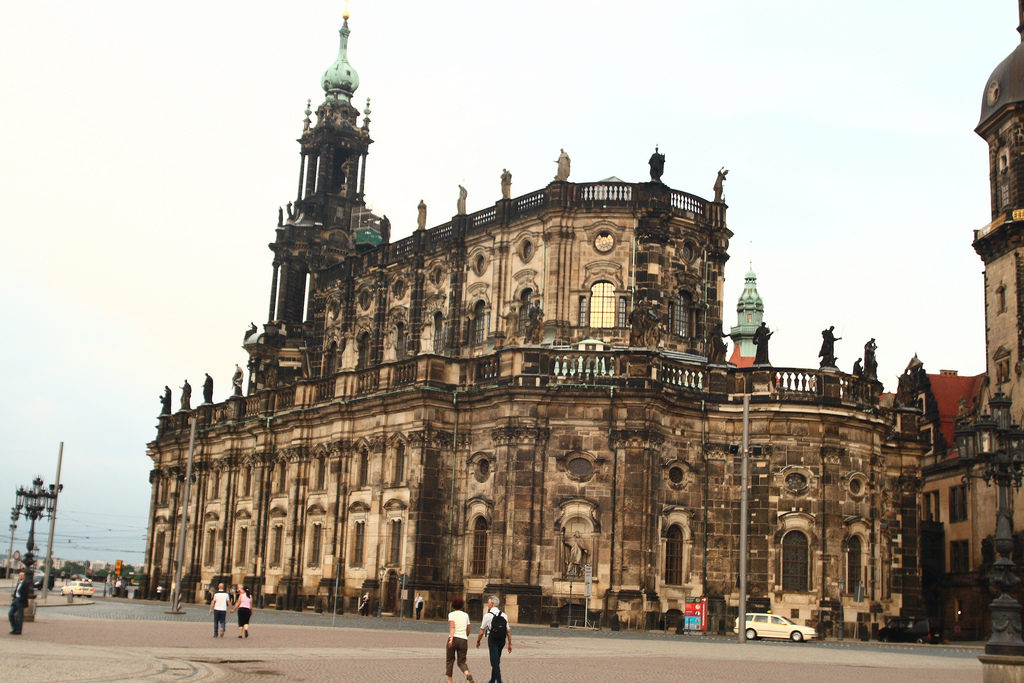I recently posted on the pleasure of exploring the ‘in-between’ places, such as North Wales, on tour. Those places that might not have people breaking down doors to get an application form in, but are a wonderful surprise on tour. Today I feel I should share another favorite, Dresden. Again, as with North Wales, for many EF travelers let’s begin with “what do we know about Dresden”?
I can sense you all saying to your screens, well, it’s the Capital of Saxony, which is one of the 16 states (Bundesländer) of the reunited Germany. It was already famous in the 18th century, known as Florence on the Elbe (Elbe is the river of Dresden), built mainly by King Augustus the Strong. He invited artists, craftsmen and musicians from Venice to his court to give it an Italian flair. Much of this development was financed from the income of the Saxon silver mines. And you would be very right, have a pat on the back.
To most Europeans, the name Dresden is known for the fire-bombing raids in February 1945 that destroyed the entire 18th century residential area. 75% of all buildings were destroyed or damaged, the entire downtown completely, the fire caused by the bombing lasted two days and estimates on the number of casualties vary greatly.
If you are on tour and headed between Berlin and Prague then Dresden will certainly be a stop you make. Sometimes no more than an extended lunch stop; it is a great diversion on any travel day. Find some time to visit some 18th century survivors of the bombing, or at least some of the buildings that were reconstructed, take in some of the classics and then enjoy them more for the modern framework which surrounds them. One is the Katholische Hofkirche (Catholic Church of Court), the largest church in Saxony with the altar of Ascension by Anton Rafael Mengs inside. To the right of the church you will see a covered passage that connects the church with a building. This building with the round tower is the Royal Palace (Schloss), the official residence of the court. Inside you’ll find The Grünes Gewölbe – the Green Vault, home of the famous jewelry collection. With 3000 pieces this is one of the richest jewelry collections of the world – it was also founded by Augustus the Strong as part of his treasury.
Further to the right is the Zwinger Museum (1710). It was originally built for Baroque feasts during the reign of August the Strong, and then from the 1730s used as storage for the developing collections of the king. The Zwinger is the symbol of Dresden and a good example of German late baroque. Today it houses a world famous collection of European paintings from the 14th to 18th centuries situated on three floors. You might want to see Rembrandt´s self-portrait with his wife Saskia (1st floor, gallery 106) or Canaletto´s landscapes of 18th century Dresden.
To the right of the Zwinger is the famous Semperoper (Opera), the current building being the third on the spot with statues on the facade of Shakespeare, Sophocles, Moliere and Euripides. From Theaterplatz, you can cross the street (Sophienstraße) and walk between the church and the Palace and down fabulous Augustusstraße with its 150 foot long Procession of Dukes – murals depicted on the outer wall of the former Stendehaus (Royal Stables). The scene, a long row of royalty on horses, was first painted in 1876 by Wullhelm Walther and then transferred to some 25,000 Meissen porcelain tiles, which make up the mural. The oldest king here is more than 800 years old.
Walk on towards the Neue Markt (New Market) and on the other side of this square is the landmark of Dresden, the Frauenkirche (Church of our Lady).This Protestant-Lutheran church was also a victim of the 1945 February bombing, and was kept as a ruin by the communists to have a symbol and memory of the destruction on those two days – or rather because of lack of financial means to rebuild it. In 1992 the new government decided to reconstruct the church, financed from donations.
So, it all sounds rather fine and the bombing left plenty of good old stuff. But Dresden is a very modern city. To experience it, walk a little further, to the left of the Frauenkirche through the passageway next to the block with the Hilton hotel on it. At the end of the passageway there are some stairs leading up and back to the riverbank, the Brühlsche Terrace, a spectacular promenade that’s been called the balcony of Europe, with a pavement nearly 50 feet above the southern embankment of the Elbe. From this nicely designed terrace, you get a great view of the new city and the river.
On your way back you can stop off at any of the fine cafes and restaurants you will have passed, it is a fine city to just sit, relax and enjoy the world passing by, and that is what makes it such a worthwhile stop.
Related articles


